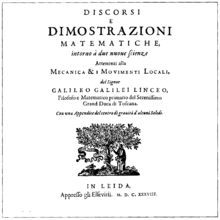Galileo's paradox

Galileo's Paradox, also known as Galileo 's Paradox or Galileo's Paradox, is a paradox about infinite sets.
It was published by the Italian scholar Galileo Galilei in his Discorsi e dimostrazioni matematiche in 1638. This was one of the infinite paradoxes with which Galileo was concerned. In the time before the discovery of calculus, he had to resort to other aids and approximations for the description of continuous movement, which confronted him with paradoxes like the classical paradoxes of Zeno of Elea .
The idea of defining infinite sets as sets that are real subsets of themselves is attributed to logicians from Galileo into the Middle Ages (such as Adam Parvipontanus ) and also to ancient authors ( Plutarch , Proklos ), and in the 19th century to Bernard Bolzano .
statement
Galileo established that the natural numbers and the square numbers form two sets of equal size, because every natural number can be assigned its square and, conversely, every square number its integer root.
- Natural numbers:
- Square numbers:
On the other hand, the square numbers form a real subset of the set of natural numbers, so there are obviously “more” natural numbers than square numbers.
The scientist Filippo Salviati , friend of Galileo, presented the argument in his Discorsi and notes that it would be an example of what happens when we try to understand the infinite with our finite brains and ascribe to it properties that only apply to the finite.
Today's interpretation
In today's view of set theory , which goes back to mathematicians like Richard Dedekind and Georg Cantor , sets are regarded as having equal power if there is a bijection between the two sets. All countable sets are therefore equal.
Galileo's paradox is used in today's approach to the definition of infinite sets . A set is infinite if and only if it is equal to one of its real subsets.
See also
Web links
- Matthew Parker: Philosophical method and Galileo's paradox of infinity.
Individual evidence
- ^ Galileo: Dialogues concerning two new sciences. Dover, 1954, p. 31 (translator Henry Crew , Alfonso de Salvio). Meetings on day 1.
- ^ William Kneale, Martha Kneale: The Development of Logic, Oxford. Clarendon Press 1962, p. 440.

